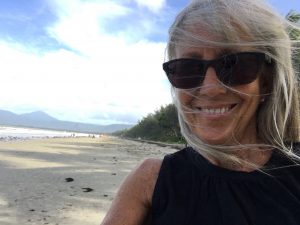Saturday was a beach day. It was still windy so a trip out to the reef wasn’t feasible, so I went to my happy place and sat on a chair and read my book and enjoyed the breeze and the waves. The only thing of real interest for the day was watching a full grown man act like a child in the pool right below my balcony. What is it about the sun and a pool and a bunch of inflatables that can reduce even the most adult of us to the behavior of a 5-year old? The need to play drives us at any age!
Today I was off on the Silver Sonic, one of the (many) Quicksilver boats that offer trips out to various reef sites. This one promised fewer people, some divers and some snorkelers, and a fast catamaran to reduce the amount of time enroute and providing more dive time. I chose well.
The Great Barrier Reef, a UNESCO World Heritage site, is the largest living thing on Earth, and is even visible from outer space. The 1,400 mile-long ecosystem comprises thousands of reefs and hundreds of islands made up of over 600 types of hard and soft coral. It’s home to countless species of colorful fish, mollusks and starfish, plus turtles, dolphins and sharks. It stretches from Bundaberg in the south, all the way to Papua New Guinea and is longer than the Great Wall of China. There’s been quite a bit written lately about the impact of global warming on the reef, and the evidence of bleaching is visible even in the north. That said, the reefs that I visited today were mostly still colorful — the Agincourt Ribbon Reefs are north and east of Port Douglas and sit right on the edge of the Continental Shelf. (The drop-off to Nemo). We went to three different reef areas, and at each you could see the change in the color of the water as it led to the much deeper Coral Sea.
(Once again I’m struck by all the uses of the word ‘great’ — the reef, the wall in China — maybe we just need to re-name a few things in America and we will have met the promise of the short-fingered vulgarian. “The Great Canyon” anyone? We already have the Great Lakes and the Great Salt Lake… what else can we re-name?)
Anyway, the trip out to the reef was rough — the seas were stirred up by the wind and a few people lost their breakfasts. I wore my sea-bands (love those things) and weathered it fine. The snorkeling was good despite some wave action. We were given lycra suits to wear to stave off any jellyfish stings — they were very lightweight and covered from head to toe, so we had no worries. The sun was shining so the clarity was perfect — just a bit tricky not to get a mouthful of sea water and hard to hold my underwater camera steady. But the colors of the coral were magnificent — some evidence of bleaching, but not much compared to further south (so we are told). Yellows and vibrant blues and pinks and oranges in coral of all shapes and sizes — hard coral is reef building coral; they are made up of hard limestone skeletons, which form the basis of coral reefs (staghorn coral, brain coral, luna coral etc). Soft corals look like colorful plants and do not build reefs but will grow on top of hard coral (elephant ear coral, cauliflower coral, weeping coral and sea whips etc). There were hundreds of fish of different sizes and shapes — parrotfish, butterfly fish, maori wrasse, a reef shark, a giant clam which was maybe 30 years old, sea cucumbers and I did find Nemo hidden in an anemone. (The photos are just okay, and not available to publish now).
We had three dives in separate locations all on the same section of the Agincourt ribbon reefs, and each site delivered. It was difficult to put those wet lycra suits back on between snorkel spots — it was too windy (chilly) to leave them while sailing from spot to spot. I was happy for the hand held hot shower to rinse off after the final swim.
And then it was back to Port Douglas — a little less bumpy on the way back thank goodness — and an evening dining in the village. A lovely day.









(Not a photo I took — it’s the trick of taking a picture of a postcard!)
